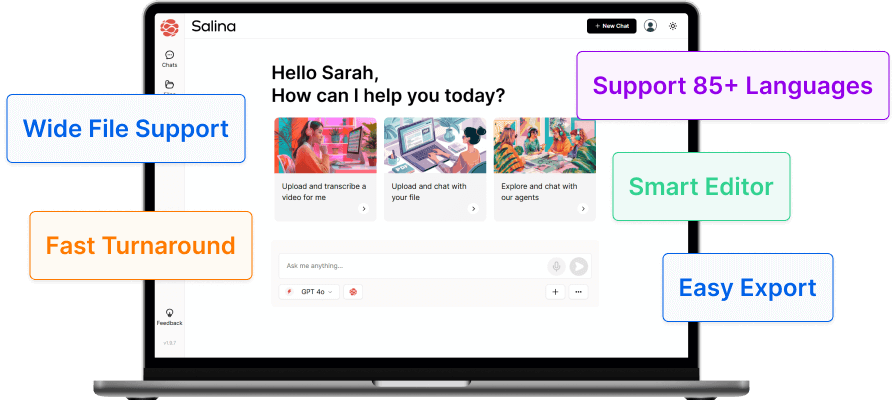Explore effective tools and strategies to summarize PDFs and streamline research. Enhance productivity in academic and professional settings with these valuable resources.
My grandma could talk for hours about her garden. She’d describe each vegetable, every flower, with the same loving detail, leaving me overwhelmed with information. One day, after a particularly long monologue about her prize-winning zucchini, I politely interrupted.
“Grandma,” I said, “I love hearing about your garden, but sometimes it’s like you’re showing me the whole grocery store at once! My plants keep dying. Why doesn’t it bear any fruit?
From then on, when Grandma would launch into a garden update, I’d gently remind her, “Just the juicy bits, Grandma!” It became our little joke.
Getting to the key points of the long-winded document is like picking the ripest tomatoes from the vine by skimming the entire patch. You focus on the most important details and the key takeaways and leave the rest out so that you can accomplish your task efficiently.
In this blog, I’ll share a list of tools and helpful tips to help you seamlessly find the juicy bits of information for efficient research.
How to summarize PDFs: A Step-by-Step Guide
Step 1: Preliminary Analysis and Contextual Understanding
The first step in summarizing a PDF effectively involves a thorough preliminary analysis to gain a contextual understanding of its content, moving beyond basic skimming to a more structured approach that identifies the document’s key elements and overarching message.
Tips for Preliminary Analysis
- Start by thoroughly reading the introduction and conclusion to grasp the document’s goals and main findings, ensuring you understand the overall storyline.
- Look at the headings and subheadings layout to see how ideas are organized and differentiate main arguments from supporting details.
- Keep an eye out for repeating terms, phrases, or concepts, as they highlight the document’s key points and central themes.
- In academic texts, analyze the methods and results to evaluate the study’s credibility and its impact on the field, offering a critical perspective for summarizing.
Step 2: Highlight and Annotate
Once you’ve completed the skim, go back through the document and this time, highlight key statements, facts, and figures. Utilize annotation tools to add comments that will serve as reminder notes of why the highlighted section is important.
Tips for Annotation
- Use color coding to help categorize your highlights; for instance, one color for key findings and another for supporting evidence.
- Add your thoughts and questions as annotations; it will help prompt deeper engagement with the material as you summarize.
- Aim for a balanced distribution of highlights; remember, the summary should be a proportional representation of the original content.
- Be selective—annotate only those points that are truly essential to the central narrative.
Step 3: Paraphrasing Main Ideas
With the document thoroughly skimmed and annotated, it’s time to paraphrase what you’ve identified as the main ideas. Paraphrasing ensures that you’ve understood the content and that you’re able to articulate it in your own words.
Tips for Paraphrasing
- Resist the urge to copy-paste using the original documentation, and it’s crucial to maintain originality.
- Re-read the parts that you’ve annotated, process the information, then attempt to verbalize the concept on your own.
- For technical terminology, ensure you understand the precise meaning and context. Use simpler language where appropriate in your summary.
- Aim for brevity; your goal is to express the point effectively in as few words as possible.
Step 4: Structuring Your Summary
A sound structure is the backbone of any good summary. Organize your paraphrased points into an order that flows logically, mirroring the structure of the original document if it makes sense to do so.
Tips for Structuring
- Separate your summary into distinct sections, potentially using the same headers as the original document’s chapters or sections.
- Begin with a clear introduction that outlines what the summary is about and what the reader can expect to learn.
- Build from general to specific in your sections, and end with a powerful conclusion that restates the main points.
- Use bullet points or numbered lists for a breakdown of complex ideas or when presenting multiple findings.
Step 5: Critically Review and Revise
The final step is to review your summarized content critically. Ask yourself whether you’ve missed any crucial points or included redundant information. Ensure the summary remains true to the original piece but also reflects your understanding and interpretation.
Tips for Reviewing
- Take a break and return to the summary with fresh eyes to spot any potential flaws.
- Seek feedback from a peer or colleague, especially one familiar with the material or the subject matter.
- Rewrite any sections that do not flow well or fail to convey the intended message clearly.
- Consider the length of your summary; while it should be comprehensive, it should also be concise.
Tips for Efficiency
Tip 1: Get Comfortable with the ‘Skim-Read’
Efficient skim-reading is key for easy summarization. Read swiftly, focusing on comprehension. Begin with the title, intro, conclusion, and move to topic sentences for main ideas. Practice hones this skill, improving swift critical information extraction.
Tip 2: Master the ‘Rule of Thirds’
For a concise summary, follow the ‘Rule of Thirds’:
- 1/3 for intro and setup
- 1/3 for main points
- 1/3 for conclusions and implications.
This method balances information in your summaries, making them comprehensive yet focused.
Tip 3: Use Summarization-Specific Apps
There’s an app for nearly everything, even summarization. Apps like Qiqqa or ReadCube focus on aiding readers in handling and simplifying complex texts. They provide functions like tagging, annotation, and sometimes, integrated AI summarization tools. These apps aim to streamline research and summarization, making them valuable for frequent readers and summarizes.
A Look at More in Depth Tools
Summarizing PDFs is quite a tedious process, but with the help of AI automation, you can significantly simplify and improve your workflow efficiency. By leveraging these innovative tools, you can enjoy the benefits of accessibility and enhance your summarization process.
AI has its benefits, but certain tasks are best suited for different software. This is where the tool recommendations below become valuable. They provide not only PDF summarization tools but also other software options that excel in collaboration and document annotations. Let’s go through all of them together.

AI-Driven Tools
AI-Powered Summarizers
AI-powered summarization tools like ChatGPT can process vast amounts of text and generate coherent and concise summaries predictively. They are effective at summarizing large volumes of documents quickly, extracting key information, and maintaining the logical flow of the content. One such tool is UPDF, which employs advanced AI to generate summaries that are both precise and contextually relevant.
How They Work:
These tools use natural language processing (NLP) technology to understand text and its contextual meaning, which allows them to summarize content with a high degree of accuracy.
Pros
- Fast and efficient, suitable for bulk summarization.
- No cognitive bias; the summary is entirely fact-based and objective.
Cons
- The output may lack a ‘personal touch’ or the judgment of a subject matter expert.
- The cost-effectiveness may vary, and the learning curve for integration can be steep.
Text Summarization APIs
For those with programming skills or access to a developer, incorporating a text summarization API can be a powerful solution. APIs like AskYourPDF, UPDF, or PDF Gear allow for the automating of PDF summarization within your company’s workflow or a specific app.
Integration Considerations:
- Understand your integration options, such as using RESTful APIs or SDKs.
- Check for developer-friendly documentation and support resources.
Pros
- It enables the scaling of summarization tasks, especially in digital ecosystems or platforms.
- There’s potential for some elements of personalization and contextual awareness, depending on the API’s sophistication.
Cons
- Requires technical expertise to set up and maintain.
- The quality of the output can vary significantly based on the API’s underlying algorithms and training data.
Other Software and Tools
Annotation Software
Annotating directly on PDFs can be a game-changer for efficient summarization. Tools like Adobe Acrobat Reader or PDF Expert allow for the addition of sticky notes, text highlights, and shapes to mark information. They provide the added benefit of keeping the context within the document itself.
Key Features:
- Flexible highlighting and note-taking with a variety of tools.
- The availability of the ‘document snapshot’ feature provides immediate references to the original text.
Pros
- Ensures that the summarizer can directly interact with the text, which aids understanding and engagement with the material.
- It supports a more thorough and personalized summarization process.
Cons
- The annotated PDFs can get cluttered, making it difficult to decipher the original content.
- Not all annotation software is created equal; some may have a steeper learning curve or cost more.
Collaborative Annotation Tools
When summarization is a team effort, having a tool that supports collaborative annotation can be invaluable. Platforms like Hypothesis or Mendeley allow multiple users to interact with and comment on the same document. This fosters teamwork, ensures that all key points are noticed, and provides a forum for discussion regarding which points are most salient for the summary.
Key Features:
- Real-time decision-making during the summarization process.
- A centralized platform for all annotations, which can help ensure a uniform style and standard for all team members.
Pros
- Encourages a knowledge-sharing and learning environment among team members.
- The collaborative aspect leads to richer and more robust summaries.
Cons
- It can be challenging to manage multiple annotations effectively, especially in larger teams or with copious documents.
- Balancing individual perspectives and team consensus can be delicate, and may require a skilled moderator.
Related Content: 6 BEST AI Tools to Chat with PDF
Key Takeaways
Summarizing PDFs is a vital and often overlooked skill that can significantly enhance efficiency in knowledge management and academic research. By employing systematic approaches, harnessing the power of tools, and adhering to best practices, anyone can become adept at producing insightful and succinct summaries.
- NLP tools: fast but lack a personal touch
- Annotation software: personalized but may clutter docs
- Text Summarization APIs: automated, scalable, tech expertise needed
- Efficient skimming & ‘Rule of Thirds’: key for concise summaries
- Specialized apps & collaboration tools improve knowledge management
What’s Next
In conclusion, mastering PDF summarization is an ongoing learning process that streamlines research, enhances collaboration, and improves understanding of complex subjects. Whether exploring AI tools or refining annotation techniques, focus on summarizing rather than simplifying or shortening. Each new content piece refines your approach, consolidating knowledge for personal and professional growth.
Armed with these insights, it’s time to enhance your research by summarizing efficiently and redirecting time from full papers to broader academic pursuits.




